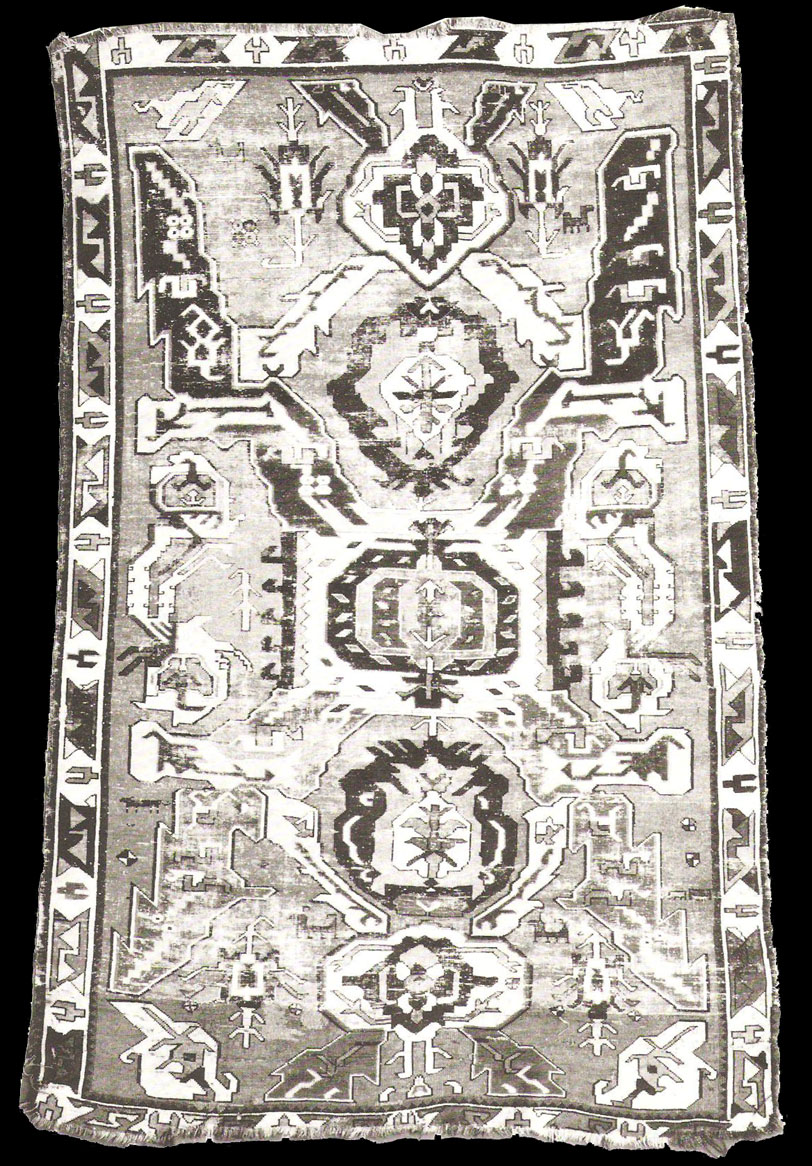|
Degenerate Dragon Rug. Karabagh? Early or Mid-19th Century. Textile Museum
R. 36.1.7 (formerly R 2.66).
Apparently this graceless rug has come from
the same looms as Plate 13 but its design harks back to different models.
These had balanced layouts, misusing the "blazon" palmette as a hinge, with
the lower half mirrored above its center. This has resulted in dragons with
a head at each end, as in West Berlin I.8/59 or with none, as in St. Louis
Art Museum 109.29, where they have two tails and no heads and are no longer,
therefore, dragons. The St. Louis rug (Dimand 1935: PL LX), shows the
disciplined drawing of the early 18th century. The Berlin rug (Erdmann 1970:
Fig. 197), is intermediate in draftsmanship, showing the sort of two-headed
dragons (in Medieval terminology, "backbiters") upon which those of the
Textile Museum rug were based. Both the Berlin and Washington rugs have no
proper field beginning, having been based on rugs in which this was missing.
They have the same fundamental layout of the band systems, with prominent
palmettes on the center line. In corner panels the Berlin rug's palmettes
have disintegrated into a handful of feathers and small beasties; in the
Washington rug they have become carriage lamps.
The field is crimson brick; the band systems yellow and blue-greens,
abrashed with dark blue. The dragons are ivory, as usual in this series. The
border is ivory, with varicolored details.
A rug of this kind has been copied in local weaving in a carpet which was
recently in the Capan Oglu mosque at Yozgat in Anatolia, east of Ankara.
This repetition includes the double-headed dragon and even the "carriage
lamp" palmettes. The color scheme too is similar, except for a light blue in
the border. Otherwise the Textile Museum rug compares with Plate 13 and with
the Cassirer and Pallavicini auction rugs mentioned in connection with it.
Size: L. 2.49 m. (8'2") x W. 1.60 m. (5'3").
Warp: Z3S wool in a complete range of natural shades, light, dark and
tricolored barberpoles (ivory, russet and brown). One level. Toward top of
rug, splices in red, dark medium blue, black-brown etc.
Weft: Z2S wool in mixtures dyed dark medium blue for 13" at bottom; then for
balance of rug Z2S ivory cotton. Three and two shots. In some places 2 or 3
extra shots added at sides or weft wedging, evidently to even out.
Pile: 27. wool. Gordes knotted, pile slanting slightly to right. A few knots
are offset. 8 or 7 horiz. x 6 or 9 or 10|+ vert, per in. (52 to 72 per sq.in.).
Sides: Missing. Weft returned around outer warp of pile. suggesting a
selvage-attached finish.
Ends: Cut.
Colors: Ivory; black-brown; dark orange; yellow; crimson brick red; dark and
dark medium blues; blue-blue-green; blue-green; violet.
Condition: Shows considerable wear. Published: Ellis 1970: Fig. 4.
|

